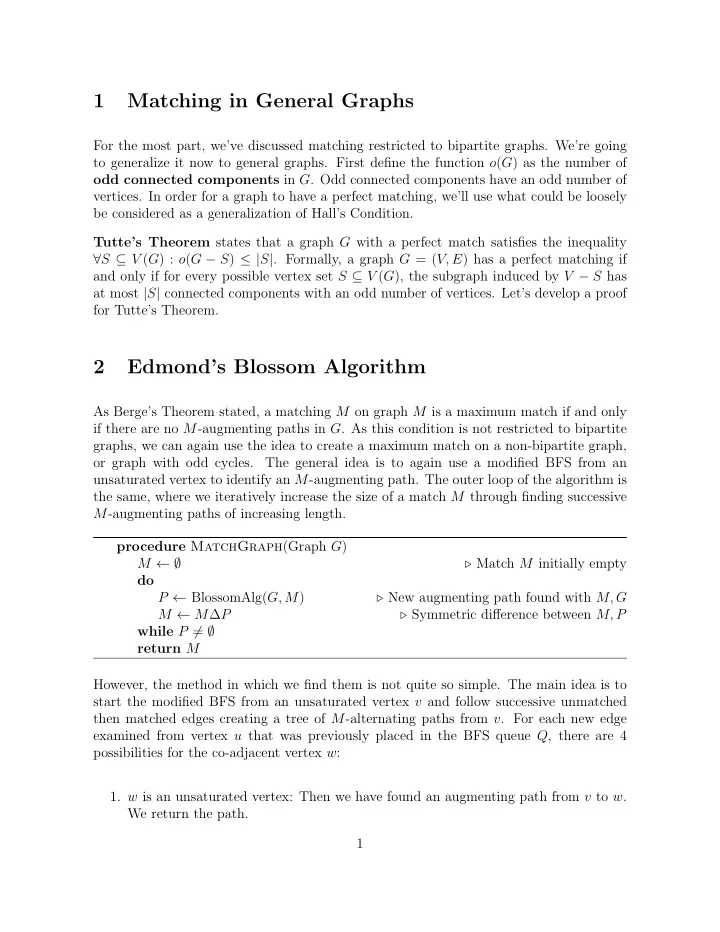

1 Matching in General Graphs For the most part, we’ve discussed matching restricted to bipartite graphs. We’re going to generalize it now to general graphs. First define the function o ( G ) as the number of odd connected components in G . Odd connected components have an odd number of vertices. In order for a graph to have a perfect matching, we’ll use what could be loosely be considered as a generalization of Hall’s Condition. Tutte’s Theorem states that a graph G with a perfect match satisfies the inequality ∀ S ⊆ V ( G ) : o ( G − S ) ≤ | S | . Formally, a graph G = ( V, E ) has a perfect matching if and only if for every possible vertex set S ⊆ V ( G ), the subgraph induced by V − S has at most | S | connected components with an odd number of vertices. Let’s develop a proof for Tutte’s Theorem. 2 Edmond’s Blossom Algorithm As Berge’s Theorem stated, a matching M on graph M is a maximum match if and only if there are no M -augmenting paths in G . As this condition is not restricted to bipartite graphs, we can again use the idea to create a maximum match on a non-bipartite graph, or graph with odd cycles. The general idea is to again use a modified BFS from an unsaturated vertex to identify an M -augmenting path. The outer loop of the algorithm is the same, where we iteratively increase the size of a match M through finding successive M -augmenting paths of increasing length. procedure MatchGraph (Graph G ) M ← ∅ ⊲ Match M initially empty do P ← BlossomAlg( G, M ) ⊲ New augmenting path found with M, G M ← M ∆ P ⊲ Symmetric difference between M, P while P � = ∅ return M However, the method in which we find them is not quite so simple. The main idea is to start the modified BFS from an unsaturated vertex v and follow successive unmatched then matched edges creating a tree of M -alternating paths from v . For each new edge examined from vertex u that was previously placed in the BFS queue Q , there are 4 possibilities for the co-adjacent vertex w : 1. w is an unsaturated vertex: Then we have found an augmenting path from v to w . We return the path. 1
2. w is already matched and not contained in the BFS tree T so far: Then we add w and its matched neighbor x to T and put x into the BFS queue Q n . 3. w is already contained in T and we have detected a cycle of odd length via a non- tree edge: We identify the cycle as the the shortest path from w to u and perform a contraction on the entire cycle. 4. w is already contained in T and we have detected a cycle of even length via a non-tree edge: We do nothing in this instance. Even cycles can’t help us. A contracted odd cycle in T is referred to as a blossom , hence the name of the algorithm, Edmonds’ Blossom Algorithm . An odd cycle can be traversed in either direction from v , which allows us to explore any adjacent unsaturated edge. Note in item 2 above: to enforce T as being M -alternating, we initially only place in Q n the second vertex x of a newly discovered match ( w, x ) for further exploration. By being able to reach w via x by traversing an odd cycle containing them both, we break this restriction and can now also explore edges from w . 2
procedure BlossomAlg (Graph G ( V, E ) and matching M ( V M , E M )) G ′ ← G for all v ∈ V do marked ( v ) ← false for all v ∈ V : v / ∈ V M , marked ( v ) = false do marked ( v ) ← true Q ← v, Q n ← ∅ T ← v ⊲ Modified BFS tree while Q � = ∅ do for all u ∈ Q do for all w ∈ N ′ ( u ) do if w / ∈ V M then ⊲ w is unsaturated return shortestPath( T, u, v ) +( u, w ) else if marked ( w ) = false then ⊲ Not in T yet x ← y ∈ N ( w ) : ( y, w ) ∈ E M ⊲ Vertex w ’s match marked ( w ) , marked ( x ) ← true T ← T + ( u, w ) + ( w, x ) Q n ← x else if abs( level( T, u ) − level( T, w )) mod 2 = even then ⊲ Even level difference on non-tree edge means blossom found B ← shortestPath( T, w, u ) + ( w, u ) G ′ ← G ′ · B ⊲ Contraction of blossom T ← T · B b ← contracted blossom vertex marked ( b ) ← true Q n ← b return ∅ 3
Recommend
More recommend